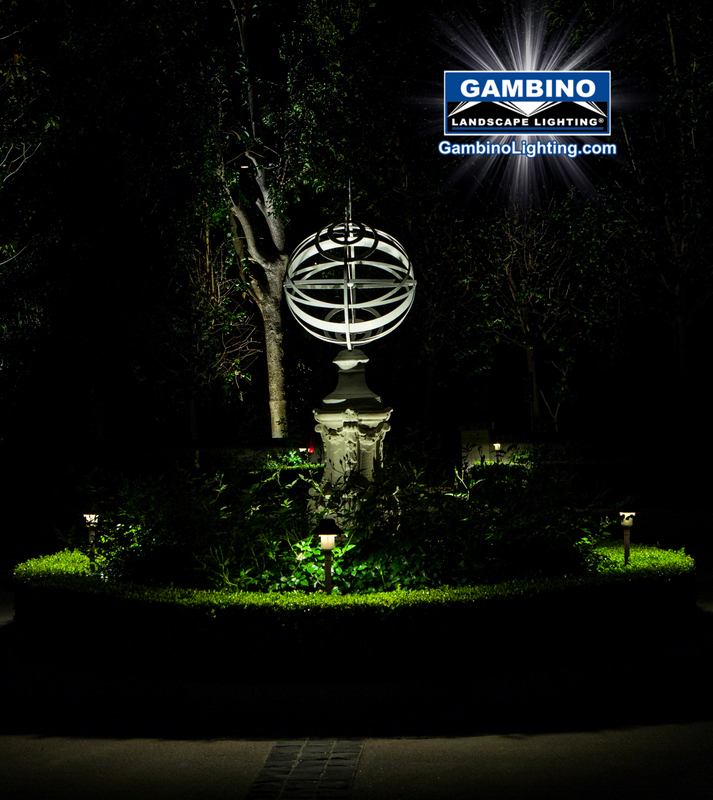27 Mar Seven ways light can create a warmer welcome in the landscape garden
By Mike Gambino
 A huge amount of time and money is invested in creating just the right ambience in the landscape garden and it goes without saying that lighting has a major role to play at night.
A huge amount of time and money is invested in creating just the right ambience in the landscape garden and it goes without saying that lighting has a major role to play at night.
And yet lighting is often neglected or added as an afterthought when it should be central to the design. The fact is, a good-looking landscape garden can be turned into a great looking outdoor room with specific function and an extension of the home at night.
Here are seven important points to follow to make sure your outdoor spaces look great and enhance and increase use and relaxation after dark.
1 Color temperature
The color of lighting has a big influence on our feelings and actions. Very warm tones of white, firelight from a flame or incandescent lamps, have a color temperature of between 2200 and 2700K, which has a calming, restful influence on us. As color temperature rises towards 4000K the white light has a cooler appearance and we become more alert. There is a connection between color temperature and illumination levels. This scientific research has established a band of values of color temperature, illumination levels that are comfortable and pleasing. Some installations are now being fitted with LED light sources with a color temperature of about 5000K, resulting in low illumination and a bluish, cold lighting effect. I feel that this has resulted in many people still believing that LED lighting use will create this kind of unappealing environment. However it doesn’t have to be that way as Quality LED’s from a reputable source have advanced to be able to replicate the warm white incandescent light bulb that we are most comfortable with.
2 Color rendering
Color rendering is the quality of light and the way in which colors are represented to our eye. It is measured as color-rendering index (CRI), with daylight producing perfect color presentation and a CRI of 100.Excellent color rendering for good color matching is 90, and good color rendering for garden lighting is 80 or above. Below these values, colors can look washed out or unnatural. Cheap and poor quality LEDs can have a CRI as low as 60. At these levels the human face can appear sickly – not good at all in a setting where people will be present.
3 Low-glare fixture shielding
Baffles conceal the illumination source. If the light source is visible, this will cause glare when you are trying to illuminate a space. By concealing the light source behind a reflector or recessing it in the body of a fixture, a space can be effectively illuminated without uncomfortable glare.
4 Illumination of vertical surfaces
As we walk around, our initial observations tend to be at eye level, so our first impression of a space is often the treatment of the vertical surface. A space can be made to appear welcoming and interesting by illumination of the perimeter fences, hedges or trees or by highlighting textured surfaces like stucco walls.
5 Lighting scenes
Providing alternative lighting scenes influences the way we feel about the space we are in. Considering what the space will be used for will help you determine the most suitable illumination level, the architectural and decorative features will suggest lighting effects, and layers of light can be used to build a lighting scene relevant to the activity. A number of different lighting scenes allows flexible use of the space and maximizes potential use and enjoyment.
“Lighting is often neglected or added as an after-thought when it should be central to the design”
6 Good Design
Creating the best lighting scene for a space ensures the space looks its best, and Lighting can easily be designed to transition from one scene to another over varying areas of the landscape, achieving a subtle and calming change. At the other extreme, drama can be create by using bold eye catching effects where appropriate. Manual system overrides can also be accommodated for extraordinary events or the reassurance of being able to turn off certain lights at different sections of the garden with the touch of a switch.
7 Energy efficiency
There has been huge interest in efficiency over recent years in a bid to reduce our environmental impact. The cost of energy is a significant consideration. Retrofit solutions can quickly reduce energy consumption. But make sure you get good quality products that are compatible with your outdoor lighting fixtures– cheap LEDs are tempting, but if they don’t perform and are not designed for use outdoors, you may face unscheduled replacements further down the line, or worse: the decline in light quality may prompt their replacement even before burnout. Huge energy reductions can be achieved without compromising color temperature, color rendering, glare control and performance. Lighting designers have a passion for the creative process and delight in delivering enhanced outdoor spaces. To avoid expensive mistakes professional lighting designers should be consulted before making any new lighting decisions or any major changes made to your existing outdoor lighting system.
This landscape lighting blog is published by Mike Gambino of Gambino landscape lighting inc. all rights reserved. Mike is a professional landscape lighting system designer/ builder and has been designing, installing and maintaining landscape lighting systems for more than 20 years. Mike resides in the Los Angeles area with his wife and 2 sons. To visit his website go to www.gambinolighting.com . To inquire about hiring Mike please click here .
Blog articles may be published with permission on other websites without editing or removing links.



No Comments